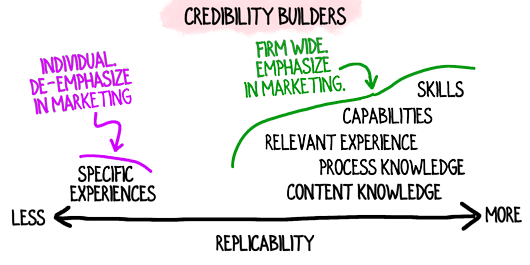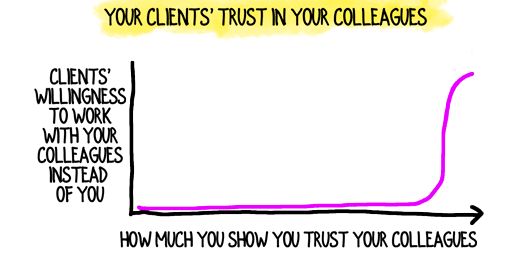How to Make Clients Comfortable that You (the Star) are Not on Their Project
If you’re known as the founder of your consulting practice (or one of the founders), you may feel your ability to scale your firm is limited because prospective clients want to work with a/the founder and there’s only so much of you to go around.
You’re a victim of “It’s gotta be you” syndrome. Fortunately, this is an easier problem to solve than many founder/owners realize.
As a founder of a consulting business, the vast majority of your firm’s engagements are won directly by you or indirectly because of you.
You generate incoming inquiries through your relationships and your appearances on stage and in writing, webinars and podcasts. Plus, of course, your TikTok videos.
Clients sign on because they believe in your knowledge, thinking and personal experience.
Yet, if you’re deeply involved in every project, the number of projects your consulting firm can handle is extremely limited. Further, devoting time to client work directly reduces your firm-building and business development capacity.
How, then, do you convince prospects to work with someone other than you (and/or other founders)?
Obviously, there’s a solution to this problem.
After all, clients invite McKinsey to lead restructuring initiatives even though James McKinsey isn’t there. They hire Booz (er… Strategy&) for strategic initiatives without expecting Edwin Booz to lead the team. They buy candy from Wonka even though Willy gave the factory to Charlie.
The five actions below will mitigate “It’s gotta be you” syndrome and vastly expand the limits for your consulting firm.
5 Steps to Make Clients Comfortable With Your Firm Even When You’re Not on Their Project
Challenge Your Assumptions
Your starting premise may be wrong. At least half of your prospects attach little or no importance to your working directly on their project, even if your consulting firm bears your name, as long as you assure them they’ll achieve their desired outcome.
Although prospects are attracted by your IP, thinking, and visibility, fundamentally they don’t care about you personally. They want the results, not the individual.
From the start of your discussions with a prospective consulting client, position your colleague as the project lead and yourself as a supporting player or not involved at all. Present that structure as an assumed fact, not as an experiment or as an idea you want to see if your client will accept.
Reframe Your Clients’ Assumptions
When prospective consulting clients explicitly request you work on their project, treat their preference the same way you’d treat any other objection to an aspect of your proposed approach:
- Ask for the reason why the client wants you on the project. In other words, expose the interests and assumptions behind their position.
- Then explain that the client’s interests can be met without your involvement and, perhaps, their results will be even better if someone other than you leads the engagement.
Hire and Believe in Great People
You’ll challenge assumptions—your own and your clients’—more effectively when you believe from the dainty tips of your toenails to your handsomely coiffed hair that your colleagues are fully capable of leading your consulting firm’s engagements.
You do not have to believe that anyone else in your firm knows everything you know or would handle every situation the way you would handle it. That’s immaterial. The two questions that matter are:
- Can your colleague lead your client to a successful project outcome?
- Will your colleague use approaches, methods and ideas that are consistent with your consulting firm’s IP?
When you hire great people, train them well, and equip them with strong systems, then you merely have to take yourself off the pedestal (you don’t belong there anyway) and let your colleagues step up.
Support Your Colleagues Genuinely
Praise your colleagues honestly and fairly. For instance, resist the urge to claim, “She knows everything I know!” That’s a disingenuous claim and it undermines your position.
In truth, your colleague doesn’t know everything you know, but also knows quite a lot you don’t know.
As noted above, your colleague doesn’t need to be a clone of you.
Your consulting firm’s obligation is to deliver results. Therefore, reassure your prospective client with genuine, heartfelt praise of your colleague. Mention her background and experience and, most importantly, convey your confidence in her.
Step Back, Not Out (at First)
Start the process of handing clients off to colleagues by remaining on every project, but in a reduced and subordinate role. Similarly, for clients who insist on your presence, join the project team in a limited, subordinate capacity.
At every turn, in every meeting and in every interaction with your client, make it clear that you’re deferring to the colleague you’ve installed as the lead.
That behavior will reinforce for your client and for your colleague that your project leader is in charge. Over time, both sides will gain confidence that you’re an ancillary, possibly disposable member of the team. Perfect!
Make sure you adopt the subordinate position from the very start of the engagement. If your colleague just sits and listens for the first couple of meetings, your client will resist transitioning away from you.
Legacy clients are more difficult to pass to other colleagues; however, the same approach will work with most of your existing clients.
Have you struggled with “It’s gotta be you” syndrome?
Text and images are © 2024 David A. Fields, all rights reserved.

 David A. Fields Consulting Group
David A. Fields Consulting Group 




Yes! We definitely deal with this. Everyone wants our founder. I think the last point is key–building him into the pitch as part of the team but in a supporting role that sets expectations off the bat and allows him to have his fingers in more of our projects at a high level. Thanks!
Yes – creating that subordinate role from the outset is important. Let me know how it works for you, Joanna.
As a founder, part of the reason I’ve been successful is because I have a lot of varied experiences that have let me address problems from broad perspective. I’ve done a lot of stuff. But it’s absolutely true that everyone I hire is better at “their thing” than I am at that thing. That’s why they’re here. This makes it easy for the client and for me to trust the team and not get hooked on my direct involvement or leadership of a project.
Jeff, it sounds like you’ve done an excellent job hiring a strong team that you trust, and also ensuring clients trust your team too. Well done!
I appreciate you sharing the case study–it will help numerous consultants who are wondering whether handing over clients to a team is really possible.